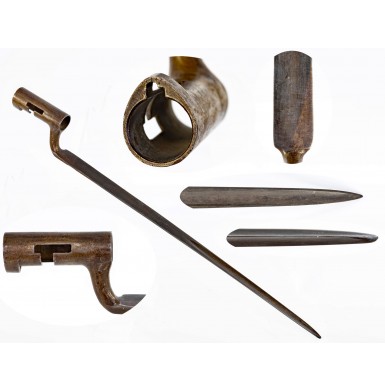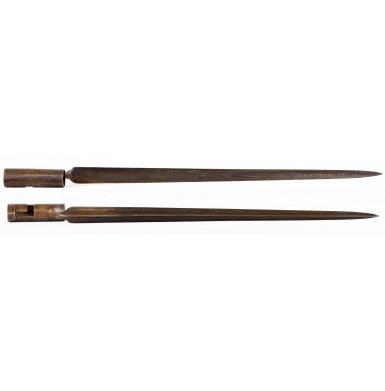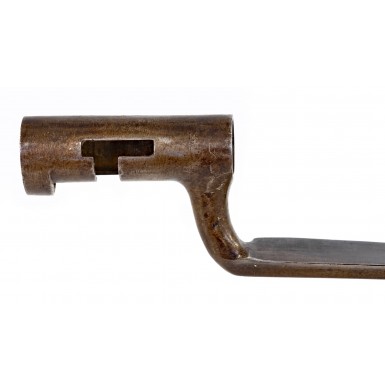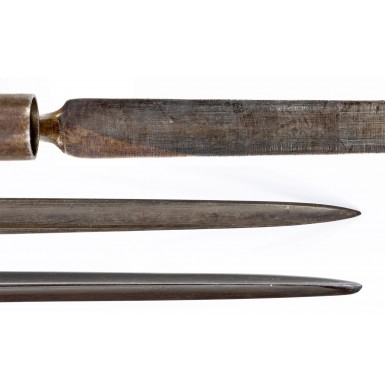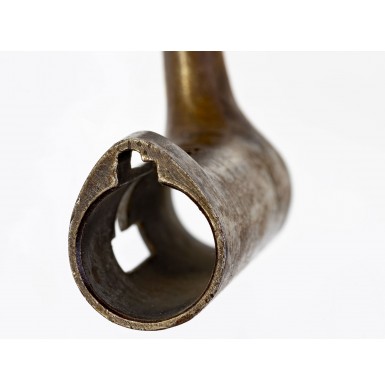Rare Variant Hall Rifle Bayonet with Browned Finish and Tapered Blade
- Product Code: EWB-2783
- Availability: Out Of Stock
-
$650.00
This is a wonderful example of one of the harder variants of the US Model 1816 style socket bayonets to find. The US Model 1819 Socket Bayonet for the Hall Rifle is essentially identical in shape and form to the US Model 1816 family of bayonets with a nominally 16” long blade, face flutes of varying length, T-shaped mortise, and no locking ring. The two major differences were the bore diameter of the socket, which was about .783 +/- for the Hall Rifle and about .830” for the Model 1816/22/27 bayonets. Additionally, the bridge of the socket for the Hall bayonet was elevated and cut with an offset notch to allow the offset front sight blade of the Hall rifle to pass into the bayonet socket. Typically, Hall Rifle bayonets were unmarked, although occasionally a marked blade is encountered. Some are marked with “US” over a pair of letters which are either those of the maker or inspector, but these are extremely scarce. It is believed that many of these letters marked bayonets were produced by contractors as one of the better-known markings “US” over “SN”, is attributed to Simeon North, the only contractor to produce Hall rifles. More often, if the face of the bayonet is marked it is simply with a single or double punch dot, or more rarely a sort of windmill (or Maltese Cross) mark. It is believed that these bayonets with simple tool marks, as well as the ones bearing no marks, were probably manufactured at Harpers Ferry. As with the M-1816 bayonet, the Hall Rifle bayonets are found with two distinct styles of blade point. The more common is known as a “prow point”, with the end of the blade being clipped and fairly blunt, resembling the prow (or bow) of a boat. The other type of point is a more conventional tapered, sharper point. It has been postulated that all Hall Rifle bayonets were only manufactured and finished “in the white”, with an arsenal bright, polished steel finish. However, based upon some extant examples this seems unlikely. From time to time a rare example surfaces with original, period applied lacquer brown finish. I think that a more realistic answer is that the bayonets for the Hall Rifle were finished in the brown during at least part of the “National Armory Brown” period, which lasted for the decade from 1822 until 1832. As production of the Model 1819 Hall Rifle did not really begin until 1823, with only about 20 rifles delivered that year, it seems logical that the early Harpers Ferry produced socket bayonets would be of the general type and finish currently being manufactured at Harpers Ferry. Only 2,000 Model 1819 Hall Rifles were produced at the Harpers Ferry Rifle works between 1823 and 1831, with 1000 officially “delivered” in 1824 and 1000 more officially delivered in 1827. Both of these deliveries took place during the National Armory Brown period. The next delivery of Hall Rifles from the Harpers Ferry Rifle works was in 1832, when 4,360 were produced. It was during 1832 that the browning of muskets was officially ended at both of the national arsenals, so I believe that the browning of the Hall bayonets ended at that time as well. Contractor Simeon North delivered only 600 Hall Rifles in 1830 and 800 in 1831. This makes the total delivery of Hall Rifles prior to 1832 only 3,400. This explains the rarity of the browned bayonets, when compared against the total production of Hall Rifles which was 25,380 counting both Harpers Ferry and Simeon North contract rifles. Assuming that only those bayonets produced before 1832 were browned, only 13% of Hall bayonets would have received that finish. Even if half of the total 1832 production of bayonets was browned as well (prior to the process being discontinued), only 6,250 bayonets would have been browned, less than ¼ of the total production of Hall Rifle Bayonets.
This wonderful example of a US Model 1819 Hall Rifle Socket Bayonet is in about FINE condition. The bayonet is a rare variant not just due to the Arsenal Brown finish, but because it has the less often encountered tapered point profile. As the large majority of extant Hall Rifle bayonets have the “prow point”, as do the large majority of US Model 1816 type bayonets, it is generally believed that the tapered blade profile is an early production feature, or possibly a very late production feature.
The bayonet still retains about 50%+ of the browned finish. The finish is worn and streaky, with the most significant loss along the high edges and contact points with the socket retaining the least amount of finish and the last 10”-11” of the blade retaining the most browning. The face of the blade is completely unmarked, which is fairly common. The only markings present are some file slash mating or finishing marks on the rear edge of the socket. The bayonet has a .781” socket bore diameter and is approximately 18 7/8” in overall length with a 15 ¾” blade. As noted, Hall bayonets were produced with two styles of blades; a clipped prow point tip that is typical of most US 1816/22/27 socket bayonets and a tip with a tapered profile. This bayonet features the tapered tip, which is less often encountered. While no definitive criteria have been developed to allow the dating of Hall bayonets, it has been surmised that these tapered tip bayonets were either very early or very late production, as the prow tip would have been typical of standard Model 1816/22/27 bayonet production. As this bayonet is also browned, I believe that it is an early production bayonet, made at Harpers Ferry between 1824 and 1826. The bayonet has a 7 ¾” face flute, but this provides no additional information regarding the date of manufacture, as face flutes on Hall bayonets tend to vary between about 6” and 10” and appear in varying lengths on both types of blades.
The blade is almost entirely smooth, with only some very minor areas of lightly scattered pinpricking present and a couple of tiny patches of light surface oxidation. A lovely, angled hammer weld line is clearly visible where the iron socket and shank are attached to the steel bayonet blade. The socket remains nice round and the T-shaped mortise remains crisp and sharp without any significant dings or mars. The bayonet is very crisp and sharp condition throughout, with only a couple of minor dings along the edges of the blade noted.
Overall, this is a really crisp and high condition example of a scarce variant US Model 1819 Hall Rifle Socket Bayonet with two rare variant features: a browned finish and a tapered point. The bayonet is in a wonderful state of preservation, with lovely original arsenal brown finish, and is almost certainly an early product of the Harpers Ferry Arsenal. If you have a high condition Hall Rifle, especially an early production gun made in 1832 or earlier, this would be a fantastic addition to the display or your rifle.
SOLD
Tags: Rare, Variant, Hall, Rifle, Bayonet, with, Browned, Finish, and, Tapered, Blade

